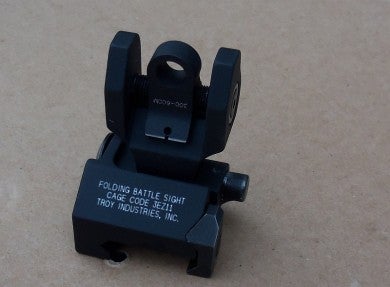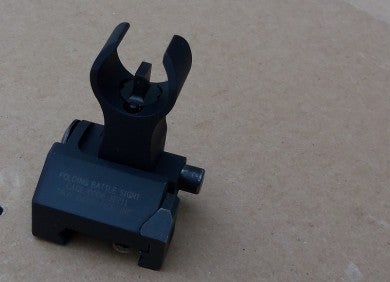For those unfamiliar with the concept of Back-Up Iron Sights (BUIS), they are just that, irons that fold out of the way when not in use, but can be quickly flipped up if for some reason an optic fails, and the shooter needs to be able to aim without the optic. Such a back up could save a range trip, save a hunt that would have otherwise been scrubbed, or even save a life.
Troy Industries’ line of BUIS is no exception to the quality they exhibit in their other products. Built from high quality aluminum and steel, they are very solidly built.
There are 3 different openings on the rear sight. The primary aperture, a large ring marked 0-200m, has a tritium vial on either side of the ring. The sights flip to a 300-600m setting which has a small aperture, with a small notch above it for extreme ranges. The tritium vials installed on these sights glow enough to be noticed in low and no-light situations, but not brightly enough to be distracting.
The sights are held in the folded position with a spring loaded detent in the sight body. This keeps them folded down when not in use, but allows them to be folded up quickly with a flick of a finger. There aren’t any buttons or other actions to make deploying these sights difficult. When the sights are folded the whole way up, the hinge pin locks very solidly in place by dropping around 2 small posts in the base of the sight. This ensures that the sight cannot be bumped down once locked into place.
Folding the sights is achieved by pushing the hinge pin in against spring pressure, and then pushing the sight back down to the folded position, where it clicks into place.
Troy BUIS mount like most any Picatinny compatible accessories to any Picatinny rail surface, via a screw-and-claw style clamp. Threads should have a low strength threadlocker like blue Loctite to ensure that they don’t back out under repeated recoil, like any sight mount should. The front sight is adjusted like any AR front sight post, by screwing it in or out with a front sight tool, or in a pinch, the tip of a bullet. A special note about the tritium model, the front sight post is set up in 2 segments, the bottom containing the threads for adjustment, and the top containing the front sight post itself. The two segments are free to rotate, so the tritium vial can be properly oriented to face the shooter once adjusted the proper zero. The rear sight is adjusted similarly to an A1 rear sight, by rotating a disc on the side of the sight assembly with a coin in the provided slot, a bullet tip in the small holes ringing the wheel, or with a thumb (and some effort) on the stippled edge of the adjustment wheel.
Pros
These sights are very impressive from a build quality standpoint. They are built from Type III anodized aluminum with stainless steel locking mechanisms, and very tightly constructed, to the point of having the most solid lockup when up I’ve seen from any folding iron sights. I wouldn’t hesitate to use these on a rifle where they would be the only sighting system, not only in a back-up role. They held up to the recoil of the Kel-Tec KSG, one of the hardest recoiling guns I’ve ever shot, a testament to how positively they lock in place and hold zero.
They have a very clever adjustment mechanism. I can’t count the number of times I’ve had to jury rig up a sight adjustment tool when sighting a rifle. By allowing for 3 different methods of adjustment on the rear sight, they’ve definitely thought of the end user frantically shuffling through their range bag for something to move their sights with.
Cons
The first thing about these iron sights, sitting like the 800 pound gorilla in the room, is the price. At MSRP, the tritium models come in at $144 for the front, and $164 for the rear, which can make any buyer cringe. However, the the non-tritium models are more affordable at $99 and $119 respectively, which I think is a very reasonable price for sights of their caliber.
I have two more small gripes, which aren’t of much consequence in the long run. First, with the HK-style globe front sight, I found myself aligning the globe with the round rear aperture instead of centering the post, which was quite distracting. This can be solved by buying the more classic M4 style front sight, which has the classic AR-shaped ears instead of the HK-style globe. Also, the mechanism to fold the sights down can be somewhat difficult to operate, given the relatively heavy spring in the hinge pin necessary to ensure such a solid lockup, which I find as a reasonable tradeoff but slightly irksome.
The Bottom Line
If you are looking for high-quality iron sights, either for an irons-only gun, or as back-up irons for a gun with an optic, personally, I would look no further if you have room in your budget for them. I’d personally skip the tritium unless you plan on shooting the gun at night, or using it as a defensive gun, as well as electing for the M4-style front sight over the HK-style. All-in-all, this is an excellent set of irons that definitely deserve consideration.
 Your Privacy Choices
Your Privacy Choices


